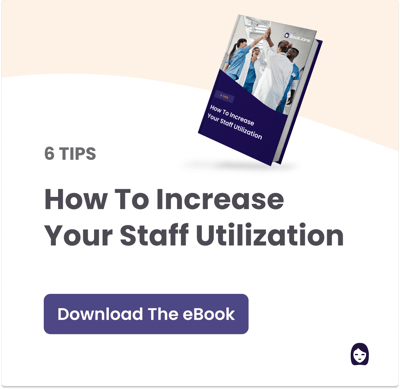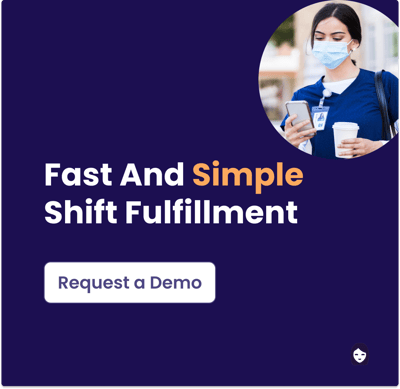
The ROI of An Optimized Workforce
As the pandemic eases and recovery becomes top of mind, inflated expenses are still posing a challenge for operators. Heightened agency usage and rates due to staff shortages and outbreak related absenteeism placed pressure on margins through 2020-2021. While the duress the pandemic had on operators’ agency usage has eased, staff shortages still post significant challenges. Making workforce optimization more critical than ever for leaders in senior care.
Workforce optimization is the strategies and practices you use that improve the efficiency of your organization, streamlining processes across all processes and employees. In a sense, it’s ‘work smarter, not harder’ - doing more with the resources you have and eliminating unnecessary bottlenecks on your productivity, rather than hiring additional staff or spending more money.
Why Do You Need to Optimize Your Workforce?
Although traditional methods of scheduling, staffing, and running a healthcare organization worked in the past, employees were already getting burned out from too many hours and not enough staff. According to Health Minister Jean-Yves Duclos, “most Canadians would agree that even before COVID-19, our capacity was often stretched too thin.”
And hospitals, clinics, and urgent care centers aren’t the only ones struggling - in the period prior to the pandemic, childcare centers, nursing homes, and other healthcare providers were already seeing long hours and worker burnout. When the pandemic hit, the industry saw a crisis of staffing unlike anything it had ever seen before.
While it might not have been possible to prepare for the challenges of a global pandemic in advance, optimizing your workforce is still a good use of your time. Research suggests workforce optimization helps business operations run smoother and organizations scale much easier when demand rises.
Much of this is due to technology, data, and analytics. When you have the right information about how your business works - the number of patients you have overall, the shifts that are hardest to fill, the number of hours each one of your employees works per week - you can use this information to structure your business decisions. Call outs can be automated to quickly offer shifts to employees that want them, bonuses can be offered to cover hard-to-fill shifts, and overtime can be tracked to prevent burnout - and all of this adds up to incredible benefits to your bottom line.
Areas to Save:
Decreased Labour Cost
Using the right technology can eliminate manual processes, administrative bottlenecks, and help you save money. While other industries have adapted to technology tools at a faster pace, healthcare is one area of business that has tended to fall behind - often because administrators are too busy to keep up with the operational workload, and because physicians, nurses, and other care workers are kept so busy with patients.
But while keeping up with new technology might not be on the top of your priority list, it can do a lot for your bottom line.
Optimizing your workforce so you make the best use of the staff you have is one way to solve the problem. Technology systems can both provide you with the data you need (such as which shifts are hardest to fill, how much utilization each staff member is getting, and when you’re paying out the most overtime) and help you to make the most of it (such as by automating call outs to go to less utilized employees first, offering incentives for shifts you would typically fill by agencies, or spreading out hours more equitably), so that at the end of the day, you’re not spending any more than you need to to keep your organization running.
Reduced Turnover
No matter what industry you’re in, hiring can be expensive. Retaining your workers is crucial to running a successful business, not just for the consistency and level of care that your patients receive, but also for your profitability overall. In general, jobs that pay $50,000-75,000 can cost businesses around $5,000-10,000 to replace workers who quit. And for healthcare in particular, this can be costly not just in terms of training and recruitment costs, but also in agency fees and overtime pay to the employees covering off shifts.
And according to a 2021 McKinsey survey, as much as 22% of nurses might leave their role in the coming year, with the biggest contributing factors being insufficient staffing (and the resulting scheduling challenges), excess workload, and emotional toll - which are all aspects that an optimized workforce can address. Making efficient use of the staff you have on hand can minimize the problem of employees feeling overworked, make better use of employees who might not feel they are getting enough hours, and lower your training and recruitment costs overall.
Other Benefits:
Improved Morale
With an optimized workforce, you can put the focus back on your patients and staff, remove stress around finances and employee turnover, and respond to new challenges, outbreaks, and staffing shortfalls with compassion for both your employees and your patients. An optimized workforce does more than just impact your bottom line: it’s what will help you and your staff cope with challenges, manage long workdays, and work effectively together as a team.
An optimized workforce is one where each employee is used to their ideal potential, taking the hours that they want without feeling overworked or looked over. Research suggests that an understaffed, overworked workforce contributes to more patient errors, lowered morale, and a sense of resentment from workers who have to pull lengthy shifts.
Automating the process can also help to eliminate employee grievances over who is given priority over shifts and when. By optimizing your workforce, you can balance out the employees who want more hours with the ones who feel overworked, sending notifications about shifts automatically and putting more of your existing workforce into action before bringing on additional staff.
More Time to Focus on Care
When more of your workforce is being used effectively, you’ll start to see benefits in patient care. Keeping shifts properly staffed in line with patient acuity levels and the number of beds you have filled can eliminate errors and help contribute to better care. And with both administrators and healthcare staff able to focus more on keeping your organization running smoothly - instead of working their way down lengthy call lists or keeping up with understaffed facilities - you’ll pass on the benefits directly to your patients.
While working in an unpredictable healthcare environment with increasing numbers of patients, scarce resources, and a limited number of staff is difficult, it’s certainly not impossible - using staffing technology can help you make the best use of what you have and keep your organization prepared for the future, no matter what!





